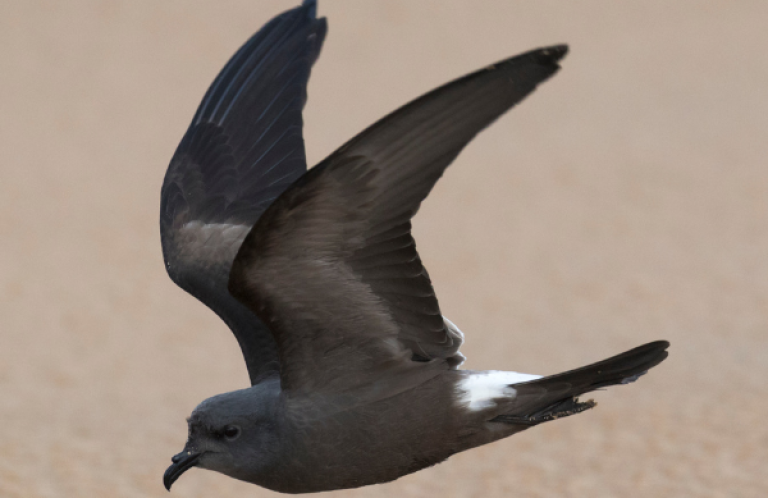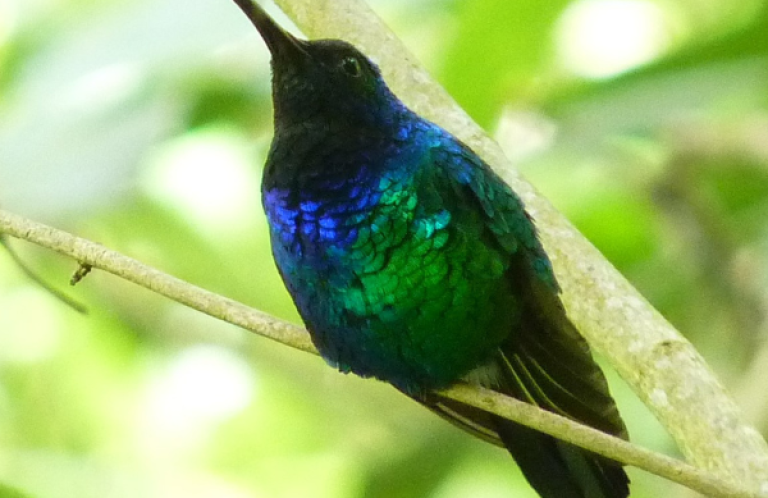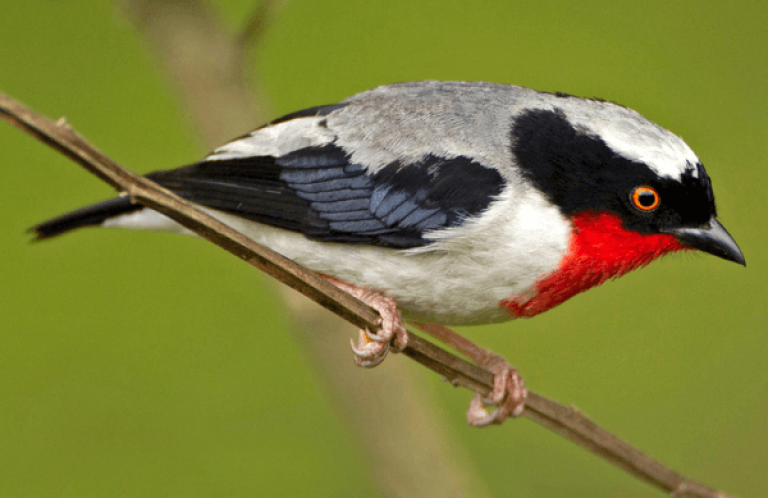New Research Reveals Habitat, Range, and Behavior of Recently Rediscovered Hummingbird Species
After its unexpected rediscovery in 2022, researchers with American Bird Conservancy (ABC), Universidad Nacional de Colombia, SELVA, ProCAT Colombia, and World Parrot Trust have released new findings about one of the rarest and most poorly known bird species in the world, the Santa Marta Sabrewing. Recently posted as a preprint in bioRxiv, the study offers a glimpse into previously undocumented feeding, singing, and courtship behaviors of this Critically Endangered hummingbird species.
“Our findings show that this amazing hummingbird may be an example of microendemism, as it seems to be restricted to a limited area within the world's most important continental center of endemism,” said Esteban Botero-Delgadillo, lead author of the study and Director of Conservation Science with SELVA: Research for Conservation in the Neotropics. “We are excited to have the opportunity to continue studying this bird because there are still huge knowledge gaps regarding its biology and distribution. Filling these gaps will help achieve our ultimate goal of finding long-lasting conservation solutions.”
Located in the isolated Sierra Nevada de Santa Marta mountains of northern Colombia, little has been known about the species as it was lost to science for 64 years before being photographed once in 2010, only to become lost again before its rediscovery in 2022 by Yurgen Vega, one of the authors of the new study. "The moment when I first found the Santa Marta Sabrewing was very emotional, I really couldn't believe it. The adrenaline, the thrill of that moment of rediscovery, it's hard to fully describe just how exciting it was," said Vega.
Just seven months after Yurgen's rediscovery, professors Carlos Esteban Lara and Andrés M. Cuervo of Universidad Nacional de Colombia independently found other individuals in additional locations within the same area. The species is listed as a top 10 most wanted lost bird species by the Search for Lost Birds, a collaboration between ABC, Re:wild, and BirdLife International. When these birds were found again, ABC and other collaborators immediately joined to help monitor and study this extremely rare population.
“After two years of researching the Santa Marta Sabrewing, we have finally made our main results public,” said Lara. “Unveiling the Santa Marta Sabrewing's story was not only possible through a joint effort between academia, local, and international organizations, but also by collaboration with the local Indigenous communities who coexist with the species. We are grateful for their help as our partnership and research continue to expand, to help implement conservation actions that benefit both the local people and the birds.”
During a period of 16 consecutive months, the team located multiple individuals of Santa Marta Sabrewing and carefully monitored their behaviors and territories. When this information was combined with reliable historical accounts, these results suggest that the species maintains year-round territories and may not be an altitudinal migrant as previously speculated. There is also strong evidence that the bird is extremely range-restricted with its presence limited to four nearby localities, all of them on the southeastern slope of the Sierra Nevada de Santa Marta, along the Guatapurí river basin.
The study also describes Santa Marta Sabrewing feeding habits and aspects of social and breeding behavior, including territorial and lekking displays, and vocal activity. Field observations and acoustic analyses indicate that male territories, leks, and possibly nesting females all seem to be strongly associated with the presence of riparian forests and watercourses, making the protection of these habitats vital to the bird's conservation. The Sierra Nevada de Santa Marta is the world's tallest coastal mountain massif and home to rich communities of wildlife, including 24 species of birds that are found nowhere else on the planet. Although much still remains to be discovered about the Santa Marta Sabrewing, ABC researchers were thrilled when they spotted the elusive bird on a recent expedition and successfully captured “jaw-dropping” images and video.
“When we first highlighted the Santa Marta Sabrewing as one of the top 10 lost birds in 2021, the species was a complete enigma,” said John C. Mittermeier, coauthor and Director of the Search for Lost Birds at ABC. “Not only could no one find the sabrewing, but no one really even knew why it had become lost. Now it feels like we have cracked the code behind this amazing species and understand, for the first time, something about it and how it managed to disappear from science for most of the past hundred years. From a Lost Birds perspective, this is just about the most exciting result you can hope for!”
These findings are a beacon of hope in an unknown territory and at the same time a call to strengthen the territorial management efforts of various actors in the habitat of the Santa Marta Sabrewing. Even so, researchers and communities understand that their presence is not assured and that it is key to create new forms of conservation that allow the well-being of the inhabitants of the area, and the care of the habitat of this species, to grow together.
The rediscovery of the Santa Marta Sabrewing has been celebrated by ornithologists around the world, including those working as part of the Search for Lost Birds. With support from ABC and partners, the research team of Botero-Delgadillo, Lara, Vega, and others are excited to continue studying the sabrewing and developing conservation actions for the species.
ABC and its partners have worked closely with the Indigenous communities in the region since the rediscovery of the Santa Marta Sabrewing. Upcoming work on the species will continue this collaboration, including discussions with local communities about further research, conservation measures, and if and how to arrange access for birdwatchers. While ecotourism has been an effective tool for supporting conservation in parts of the Sierra Nevada de Santa Marta, it also has the potential to create challenges for endangered species and people living in the region if not managed carefully. Future conservation actions and ecotourism opportunities will aim to provide lasting and sustainable benefits for both the local communities and the Santa Marta Sabrewing.
Birdwatchers interested in observing the species are encouraged to wait for more information before planning a visit. To learn how you can help support the project, visit ABC's Lost Birds Program.
Additional quotes
Dr. Daniel Lebbin, Vice President of Threatened Species, ABC
“The Indigenous communities who own the land where the Santa Marta Sabrewing lives are the stewards of the habitat for the species, and it is ultimately up to them to decide how to conserve it. ABC and our partners want to support these communities in what they need for this conservation effort, much like we have supported local partners and Indigenous communities to conserve threatened birds elsewhere in Latin America.”
Eliana Fierro-Calderon, International Conservation Project Officer for Colombia, ABC
“ABC has been working with local partners in Colombia for over 20 years to support the creation and expansion of protected areas, bird monitoring, reforestation, education, and community outreach. We are very excited about these new findings on the Santa Marta Sabrewing and the growing collaboration for the conservation of the species. Continued close collaboration between conservation groups and the Indigenous communities in the area are the only way to ensure that this amazing species never becomes lost again.”
Dr. Ian Burfield, Global Science Coordinator (Species), BirdLife International
“The new information gathered by the research team will be invaluable for designing and taking appropriate conservation measures for this Critically Endangered species. The Sierra Nevada de Santa Marta is not only a Key Biodiversity Area, but is also recognised by the Alliance for Zero Extinction as holding the world's only populations of multiple highly threatened species, including the Santa Marta Sabrewing. To prevent species extinctions, effectively conserving such irreplaceable locations is essential.”
Diego A Zárrate Charry, Director, ProCAT Colombia
“Sierra Nevada de Santa Marta is one of the most unknown and irreplaceable places in Colombia and the world, and its level of geographical isolation, the current impact of climate change and the ecological transformation on its flanks, make it a region that has an immense risk of disappearing. Even so, its socio-political complexity has made understanding the dynamics of its ecosystems and the ecology of its species a challenge. To achieve a long-term conservation impact on these unique landscapes, we must ensure that all actors in the territory strengthen their appropriation of nature, co-create new knowledge that builds bridges between diverse ways of understanding the world, and guarantee that national and international partners generate the conditions for territorial governance processes to grow and thrive.”
Christina Biggs, Lost Species Officer, Re:wild
“The Sierra Nevada de Santa Marta harbors unparalleled biodiversity, and its wildlife is stewarded and protected by the Indigenous communities that live there. The mountain range is home to many unique species, from the Santa Marta Sabrewing to the starry night harlequin toad, and it's incredibly important to partner with the communities who know the mountain range best to better understand these rare species.”
###
American Bird Conservancy (ABC) takes bold action to conserve wild birds and their habitats throughout the Americas. Inspired by the wonder of birds, we achieve lasting results for the bird species most in need while also benefiting human communities, biodiversity, and the planet's fragile climate. Our every action is underpinned by science, strengthened by partnerships, and rooted in the belief that diverse perspectives yield stronger results. Founded as a nonprofit organization in 1994, ABC remains committed to safeguarding birds for generations to come. Join us! Together, we can do more to ensure birds thrive.
BirdLife International is the world's largest nature conservation Partnership: a global family of 122 national NGOs covering all continents, landscapes and seascapes. BirdLife is driven by its belief that local people, working for nature in their own places but connected nationally and internationally through the global Partnership, are the key to sustaining all life on this planet. This unique local-to-global approach delivers high impact and long-term conservation for the benefit of nature and people.
Re:wild protects and restores the wild. We have a singular and powerful focus: the wild as the most effective solution to the interconnected climate, biodiversity and human wellbeing crises. Founded by a group of renowned conservation scientists together with Leonardo DiCaprio, Re:wild is a force multiplier that brings together Indigenous peoples, local communities, influential leaders, nongovernmental organizations, governments, companies and the public to protect and rewild at the scale and speed we need. Learn more at rewild.org.
ProCAT is a national and international non-profit NGO dedicated to the research and conservation of ecosystems and species from an interdisciplinary approach. We are a team of scientists characterized by solving complex conservation questions. Our mission is to promote, encourage and develop biological resources, social and cultural development research within a framework of sustainability. With this approach we design conservation plans for species and ecosystems through an interdisciplinary approach, in search of human well-being and biodiversity conservation. You can learn more about ProCAT on procat-conservation.org, Facebook, and X/Twitter (@ProCATColombia).
SELVA is a not-for-profit non-governmental organization founded in Colombia by individuals who dedicate their lives to research and conservation in the Neotropics. Our mission is to generate science-based knowledge that facilitates biodiversity conservation and that ultimately helps find a balance between humans and nature. We seek to inspire sustainable change leading to the protection of our natural heritage by promoting the development of new talents and collective learning. You can find us on selva.org.co, Facebook, and X/Twitter (@selvaorgco).
Universidad Nacional de Colombia is the main public university in Colombia. The university is a center of culture and knowledge and focuses on research and education at undergraduate and postgraduate levels. The university aims to prepare students with integrity, responsibility, and autonomy, oriented to be agents of change with ethical and social conscience, capable of contributing to national construction from the wealth and diversity of the regions, and from respect for the difference and social inclusion. Social media: X/Twitter @UNALoficial, @undelapaz, Instagram: @unaloficial, @undelapaz
The World Parrot Trust (WPT) brings together wildlife conservation and welfare specialists to direct effective programs to save parrots and provide technical, logistical, and funding support to our partners. WPT's approach is rooted in science, decades of first-hand experience in the field, and a deep knowledge of parrot welfare. Find us on parrots.org, Facebook, and X/Twitter (@ParrotTrust).
Media Contact
Jordan Rutter
Director of Communications
media@abcbirds.org


















































